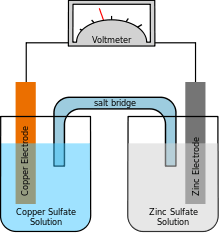Silicon–air battery
Silicon–air batteries are a new battery technology invented by a team led by Prof. Ein-Eli at the Grand Technion Energy Program at the Technion – Israel Institute of Technology.
Silicon–air battery technology is based on electrodes of oxygen and silicon. Such batteries can be lightweight, with a high tolerance for both extremely dry conditions and high humidity. Like other anode-air batteries, in particular metal-air batteries, silicon–air batteries rely on atmospheric oxygen for their cathodes; they accordingly do not include any cathodes in their structures, and this permits economies in cost and weight.[1][2]
Experimental cells using a room-temperature ionic liquid electrolytes have produced between 1 and 1.2 volts at a current density of 0.3 millamperes per square centimeter of silicon.[3]
History
The only research report available to the public was done by its creator, Yair-Ein-Eli. Eli began research in Technion – Israel Institute of Technology with David Starosvetsky, graduate student Gil Cohen of Technion, Digby Macdonald of Pennsylvania State University, and Rika Hagiwara of Kyoto University.[4] Eli's reasoning for using silicon as a fuel cell is because of its high specific energy, availability as a resource (eighth most plentiful in the universe, second most plentiful in Earth's crust), tolerance of places with high humidity, and non-toxic properties.[5] In their experiments, they tested for different potential energies and voltages, using different liquid oxygen solutions.[6] The experimental results and theories on the battery were published online in 2009 in the journal Electrochemistry Communications. This got the attention of organizations such as DARPA and the Pentagon, where they are currently working on military usage of this battery.[7] The battery is still under research by these organizations and not available for commercial use.
Design
The battery's energy source is made using an Ionic liquid known as EMI·2.3HF·F (classified in the article as an Room Temperature Ionic Liquid [RTIL]) and wafers containing high amounts of silicon. The wafers act as an Anode(fuel source) and the RTIL acts as an Electrolyte which turns the wafers into usable energy. In its idle state, the RTIL dissolves the wafers at a slow rate because there is no semi-conductor to speed up the reaction. When put into use, the RTIL will then react faster to dissolve the silicon wafers, which will produce energy for use in any electronics.[8] The battery lacks a built-in cathode that most batteries use to balance the anode's charge.[4] Instead, the membrane of the battery allows oxygen from the atmosphere to flow through it and acts as the cathode.
SPECTRE
The Stressed Pillar-Engineered CMOS Technology Readied for Evanescence (SPECTRE) is under research by DARPA and SRI. It is based on a silicon-air batteries with an added feature: in equipment where the enemy is to be denied the ability to profit from captured devices or from information to be gained from such devices, a SPECTRE battery can respond to a kill signal by self-destructing along with the device it powers. This is of potential interest mainly in military applications.[9][10]
Storage
The storage of the battery is very comparable to the Aluminum-air battery. The specific energy of the silicon-air battery is estimated to be 8470 W h/kg and the energy density is about 2109.0 W h/l. The voltage of the battery is 1-1.2 V.[6]
Applications
One particularly promising field of application for silicon–air batteries is powering small-scale medical devices such as diabetic pumps and hearing aids, in which tedious charging would be a disadvantage.[5]
The nature of the silicon-air battery also renders it particularly suitable for humid climates such as in tropical regions of Asia or America.
Research is under way to develop silicon-air batteries for everyday applications.[7] Examples include power for consumer electronics such as laptops and phones.
Efforts to develop deployable and scalable systems based on Silicon-Air technology are underway.[10]
See also
References
- ↑ Silicon–Air Battery: Non-stop Power for Thousands of Hours
- ↑ New Silicon-Air Battery to Have Unlimited Shelf Life
- ↑ "Silicon–air batteries". Electrochemistry Communications. 11: 1916–1918. doi:10.1016/j.elecom.2009.08.015.
- 1 2 "Silicon-air battery promises power for thousands of hours - Renewable Energy Focus". www.renewableenergyfocus.com. Retrieved 2015-11-09.
- 1 2 "Thousands of hours of battery, and it's green too". Israel21c. Retrieved 2015-10-20.
- 1 2 Cohn, Gil; Starosvetsky, David; Hagiwara, Rika; Macdonald, Digby D.; Ein-Eli, Yair (2009-10-01). "Silicon–air batteries". Electrochemistry Communications. 11 (10): 1916–1918. doi:10.1016/j.elecom.2009.08.015.
- 1 2 "Pentagon seeks to build a disappearing battery". USA TODAY. Retrieved 2015-10-21.
- ↑ "Silicon/Air Battery for "Vanishing" Electronic Systems | SRI International". www.sri.com. Retrieved 2015-10-21.
- ↑ "SRI International to design vanishing battery for decomposing electronics program". www.militaryaerospace.com. Retrieved 2015-11-09.
- 1 2 "Self-Destructing Electronics and Disappearing Batteries Are Coming to the Military". Motherboard. Retrieved 2015-11-09.
